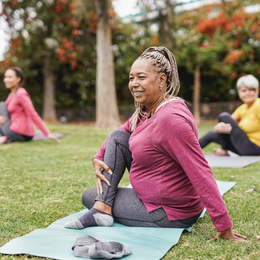
Shape Up
Want to age well? Stay fit.
Just about everyone who has ever lived to the age of 100 seems to have a different “secret sauce” they believe is responsible for their longevity. Whereas one professes the benefits of a vigorous love life, another swears by a daily intake of two shots of whiskey.
Most, however, also preach the benefits of regular exercise. Health experts do, too—for good reason. Physical activity helps older people who have chronic, disabling conditions improve their stamina and muscle strength, according to the U.S. Centers for Disease Control and Prevention. It also reduces symptoms of anxiety and depression, and fosters improvements in mood and feelings of well-being; helps maintain healthy bones, muscles, and joints; and plays a part in controlling swelling in the joints and quelling the pains of arthritis.
Johannes Burtscher, a researcher with the University of Lausanne in Switzerland, has delved into a question worth exploring: Is the body’s decline an inevitable part of aging, or is it merely the result of not getting enough exercise? His research shows that approximately half of fitness losses experienced by endurance athletes as they got older can be attributed to the aging process. The culprit behind the other half of said losses: reduced training.
In a recent story in Outside magazine called, fittingly, “Use It or Lose It,” Alex Hutchinson explores several case studies of super-athletes who have essentially frozen the biological clock by increasing their exercise as they aged. One is a man named Hans Smeets, a septuagenarian distance runner who started running at age 50. Over the next two and a half decades, the story reveals, Smeets never missed more than a week of training. Initially, he ran about 85 miles a week. Now, at age 75, he still runs as many as 50 miles a week.
Smeets is hardly alone. Just look at someone like Dwayne “The Rock” Johnson—described in a GQ story as “freakishly youthful.” He may be a celebrity and a former professional athlete, but at age 50, he appears to be stronger and leaner than he was 25 years ago, when he was in his so-called “prime.” Credit his hyper-muscular build and apparent lack of body fat to a diet filled with protein-rich foods and an aggressive training regimen—and, of course, the time and money needed to accommodate both.
While not everyone has the means or the drive to be a Hans Smeets or a Dwayne Johnson, committing to regular physical activity can limit the loss of strength and stamina typically attributed to aging. Activities such as walking and gardening, as well as low-impact exercises such as yoga and Pilates, can help to maintain cardiovascular health and flexibility, though experts also recommend weight-based exercises.
The benefits of exercise extend beyond the ability to stay mobile and active. It also improves sleep, reduces stress, and contributes positively to one’s social life. Some research suggests that the anti-inflammatory response created by regular exercise can also strengthen the immune system. In other words, “a rolling stone gathers no moss.”
Just like Smeets or Johnson, however, staying fit requires vigilance, as inactivity tends to increase with age. According to CDC estimates, approximately one in three men and one in two women engage in no physical activity by age 75.
Published (and copyrighted) in Suburban Life magazine, March 2023.


